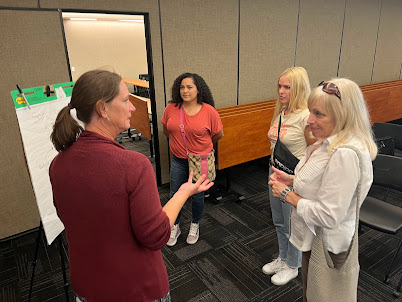 |
| NYPD officers are watched by teens. Where is the future of police crime prevention? |
by Gregory Saville
Once upon a time, I sat with famed police reformer and law school professor, Herman Goldstein, and chatted about the future of policing.
“You know, Greg,” he started, “the more change I see in policing, the more it looks like things stay the same.”
“It’s just old wine in new bottles,” I replied, hoping my trite metaphor would impress (it didn’t).
“Will police ever adopt a fundamentally better way to work with the community to solve problems?” I asked aloud, wondering what kind of response I might expect.
We were talking, of course, about the Problem-Oriented Policing movement (POP) a so-called mid-range strategy to prevent crime that Professor Goldstein founded decades earlier. As Professor Goldstein described the program in his writing, “it places a high value on new responses that are preventive. It is not dependent on the use of the criminal justice system, and [it] engages other public agencies, the community, and the private sector.”
 |
Goldstein's 1990 book, Problem-Oriented Policing, and
his 1979 article by the same name set the stage for successful police strategies |
Echoing urban writer Jane Jacobs a few decades earlier, Goldstein wrote about the need for police to engage the community: “A community must police itself. The police can, at best, only assist in that task.” That is why community engagement is at the heart of the SafeGrowth philosophy.
TRIUMPH IN POLICING
Professor Goldstein and I noted the ample evidence for POP success and how it offered a powerful crime prevention strategy. Even now, years later, researchers at the Center for Evidence-Based Crime Policy confirm that POP continues to have success in cutting street violence and drug crimes.
Researchers found that most prevention success emanates from a targeted approach at a local micro-level. They analyzed 31 projects of the latest and greatest prevention strategies at a micro-neighborhood scale and discovered half were POP oriented (13 of them had outright successful interventions and the last two were focused on tactics, not crime).
 |
Toronto police at a public event. Have police in Canada (with a few
notable exceptions) also dropped the ball on problem-oriented policing? |
In the 1980s and 1990s, the signposts for police triumph were clear. Hundreds of police agencies were trying bits and pieces of the model and reporting good results.
- Police Chief Jerry Sanders and his agency led the country with POP innovations in San Diego, California
- Police Chief Darryl Stephens had similar success in his North Carolina city of Charlotte/Mecklenburg
- The International POP conference drew over a thousand delegates with stories of reduced robberies, assaults, gang shootings, and others
- Canadian POP projects triggered Canada’s first Problem-Oriented Policing conference in Vancouver in 1995
- In Britain, a similar POP movement grew (and continues to this day).
Surely, after decades of cutting crime and building community relations, this triumph should lead to positive reform in police service delivery?
You would think.
WHERE IS THE TRIUMPH TODAY?
Somehow, in the intervening years, those efforts fell on deaf ears. Police executives I meet today seldom mention POP as one of their strategies. While the POP movement continues, and the POP conference remains vibrant and relevant, many other POP efforts faded.
The Canadian POP conference vanished. Police academies rarely teach POP in any meaningful way (or at all). When police leadership in San Diego changed, they eventually dropped POP as an embedded approach, as did many other police agencies.
In a recent SafeGrowth project we trained 35 NYPD officers alongside community residents. Mindful of the alignment between SafeGrowth and POP, I was disappointed to learn that few of those officers had any experience in POP. In fact, most didn’t know anything about problem-oriented policing.
It was a sad statement, especially since the annual POP conference, with dozens of innovative crime reduction strategies from around the world, was held later that year a short 3-hour drive north of New York City.
Of the 40,000 officers in the NYPD, I saw none at that conference. Neither did any of those 35 officers in our training attend and when I asked their Sergeants to drive up, they too were told by supervisors it was not going to happen. That is not to say other police agencies are any different or that others did not attend - they did! At least the progressive ones. But it does make you wonder why success like this does not cling to police organizations?
 |
Disney’s Jiminy Cricket – When you ask about the future of police,
you don't want to hear the sound of crickets
- Image Creative Commons |
After four decades, hundreds of POP cases reported on the POP Center website, thousands of officers attending the conferences, dozens of books, and proof of success, when I ask police trainers and leaders today about POP, I get crickets.
Chirp, chirp.
It’s a lovely sound on a warm summer night on freshly mowed grass. But in answer to the question of whether police will ever adopt a fundamentally better way to work with the community to solve problems, it is the malady of cultural amnesia.
Why do we find ourselves here?
NEXT BLOG: A POST-FERGUSON WAKEUP, HOTSPOTS, LEVERS, AND RECOVERING LOST MEMORIES
































_05.jpeg)






